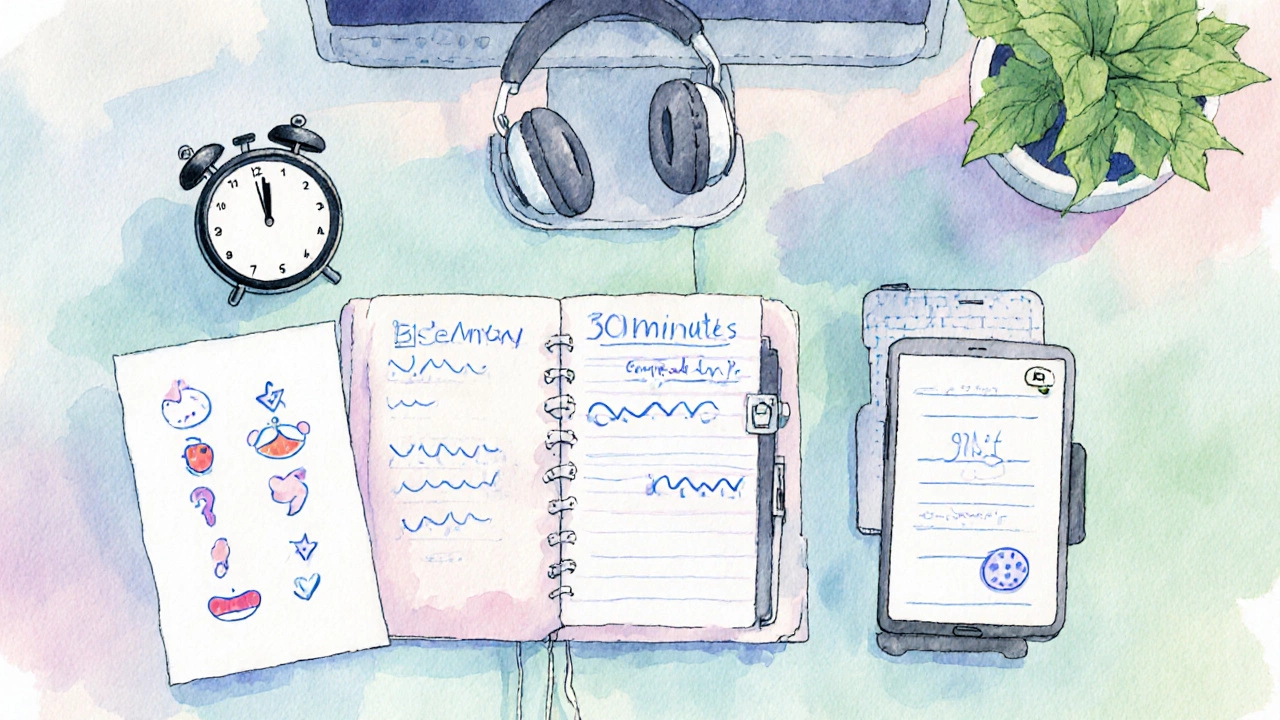
Free Ways to Speak English Fluently at Home
Free English Fluency Tracker
Daily Practice Schedule
Set a 30-minute daily speaking window for consistent progress.
Resource Selection
Choose two free resources to use daily.
Progress Tracking
Daily Routine Tips
Techniques to Try
- Shadowing Technique
- Self-recording Practice
- Narration Drills
- Language Exchange
Common Mistakes to Avoid
- Fear of Making Mistakes
- Over-reliance on Subtitles
- Single Accent Exposure
Did you know that over 1.5 billion people worldwide are trying to improve their spoken English, yet most of them never step outside their living rooms? You don’t need a pricey tutor or a trip abroad - a well‑planned, zero‑cost routine can push your confidence through the roof.
English speaking fluency is the ability to express thoughts smoothly, with correct grammar and natural rhythm, without pausing for translation. Achieving it at home hinges on three pillars: consistent exposure, active production, and smart feedback loops.
1. Design a Daily Speak‑First Schedule
Structure beats spontaneity when you’re learning alone. Set aside a 30‑minute window that you treat like a mandatory class. Here’s a simple template you can copy‑paste into a planner:
- 5 minutes - Warm‑up with tongue twisters or a short meditation to calm anxiety.
- 10 minutes - Listen to a native speaker (YouTube, podcast, or free course) and repeat each sentence aloud.
- 10 minutes - Talk to yourself about the day’s events, using the new vocabulary you just heard.
- 5 minutes - Record the monologue, play it back, and note any mispronounced words.
Consistency is king; even a half‑hour a day beats a marathon once a month.
2. Leverage Free Digital Resources
Below is a quick‑look table that lines up the most popular, genuinely free tools for speaking practice. All of them work on a laptop, tablet, or phone, so you can switch rooms without missing a beat.
| Resource | Platform | Content Type | Ideal Level | Cost |
|---|---|---|---|---|
| BBC Learning English | Web & App | Short videos & audio lessons | Beginner‑Advanced | Free |
| YouTube (search "English conversation practice") | YouTube | Live‑action dialogues | Intermediate‑Advanced | Free |
| English‑language podcasts (e.g., "All Ears") | Podcast apps | Interviews, stories | Intermediate‑Advanced | Free |
| Duolingo (Free tier) | Web & App | Gamified lessons | Beginner‑Intermediate | Free |
| Tandem language exchange | App | One‑on‑one chat/video | All levels | Free (optional premium) |
Pick at least two sources from different categories (audio + video, for example) to keep your brain from getting bored.

3. Adopt Proven Speaking Techniques
Just watching or listening isn’t enough - you must produce language actively.
- Shadowing technique: Play a short clip, pause, then instantly repeat what you heard, matching rhythm and intonation. This builds muscle memory. Shadowing technique works best with 30‑second news bites or podcast intros.
- Language exchange: Pair up with a native speaker who wants to learn your language. Platforms like Tandem or community‑run conversation club let you schedule 15‑minute video calls. Focus on “talking for two minutes, listening for two minutes” to keep the balance.
- Self‑recording: Use your phone’s voice memo feature. Record a 1‑minute story, then compare it to a native speaker’s version. Note gaps in pronunciation and re‑record until the flow feels natural.
These drills turn passive input into active output, the exact switch your brain needs to lock in fluency.
4. Turn Everyday Moments into Speaking Practice
Don’t wait for a formal session. Narrate what you’re doing while cooking, cleaning, or walking the dog.
- Describe ingredients out loud before you chop them.
- Give a weather report to an imaginary audience while you brush your teeth.
- Summarise a news article you just read in a single paragraph.
These micro‑sessions add up to dozens of minutes of speaking a day without feeling like study.
5. Track Progress with Simple Metrics
Without feedback you won’t know if you’re improving. Use these low‑tech checkpoints:
- Word count: After each self‑recording, aim to increase the number of words you can say fluently without pauses.
- Pronunciation checklist: Choose ten tricky sounds (e.g., “th”, “r”, “v”) and mark them off each week as you master them.
- Comprehension rating: After listening to a 2‑minute clip, write down three main ideas. Score yourself 0‑3; aim for a steady rise.
Review the log every Sunday - celebrate wins and tweak the schedule if a slot feels too easy or too hard.
6. Common Pitfalls & How to Dodge Them
Even the most motivated learners hit snags. Here’s what to watch out for:
- Fear of making mistakes: Remember, errors are data. Record a “mistake of the day” and turn it into a mini‑lesson.
- Over‑reliance on subtitles: Switch to English‑only videos after the first 5 minutes. If you need a translation, pause, write the word, then continue.
- Sticking to a single accent: Expose yourself to British, American, Australian, and Indian English. This broadens listening skills and reduces confusion.
Being aware of these traps keeps your momentum flowing.
Quick Checklist for Free Fluent English at Home
- ⦿ Set a daily 30‑minute speaking window.
- ⦿ Choose two free resources from the table above.
- ⦿ Practice shadowing, language exchange, and self‑recording each week.
- ⦿ Turn chores into narration drills.
- ⦿ Log word count, pronunciation wins, and comprehension scores.
- ⦿ Review and adjust every Sunday.
Frequently Asked Questions
Can I become fluent without ever speaking to a real person?
Self‑talk, shadowing, and recording are powerful, but feedback from a live listener accelerates correction. Free language‑exchange apps or community conversation club sessions provide that essential human element.
Do I need an internet connection for the whole practice?
No. Download podcasts or YouTube videos when you have Wi‑Fi, then listen offline. Your phone’s voice‑memo app works completely offline for recording and playback.
How long does it usually take to sound fluent?
Results vary, but most learners report noticeable improvement after 3‑4 months of daily 30‑minute practice, especially when they stick to the feedback loops described above.
Is there any free tool for pronunciation correction?
The BBC Learning English site offers a “Pronunciation” section with audio and visual mouth‑position guides. Additionally, the free version of Duolingo provides instant speech‑recognition feedback.
What’s the best time of day for speaking practice?
Pick a slot when you’re mentally alert but not rushed - many learners prefer morning after breakfast or early evening after work. Consistency matters more than the exact hour.






Write a comment